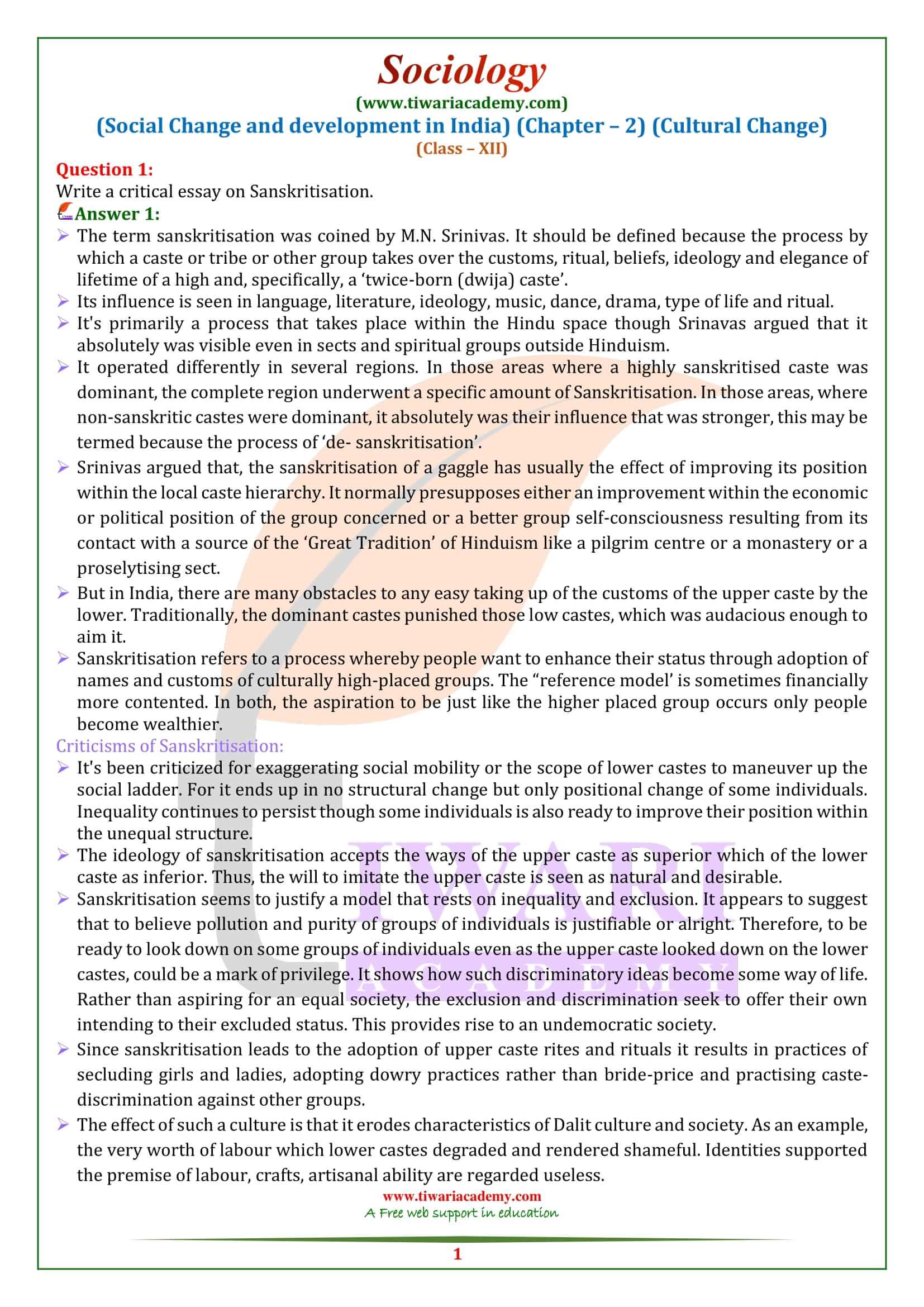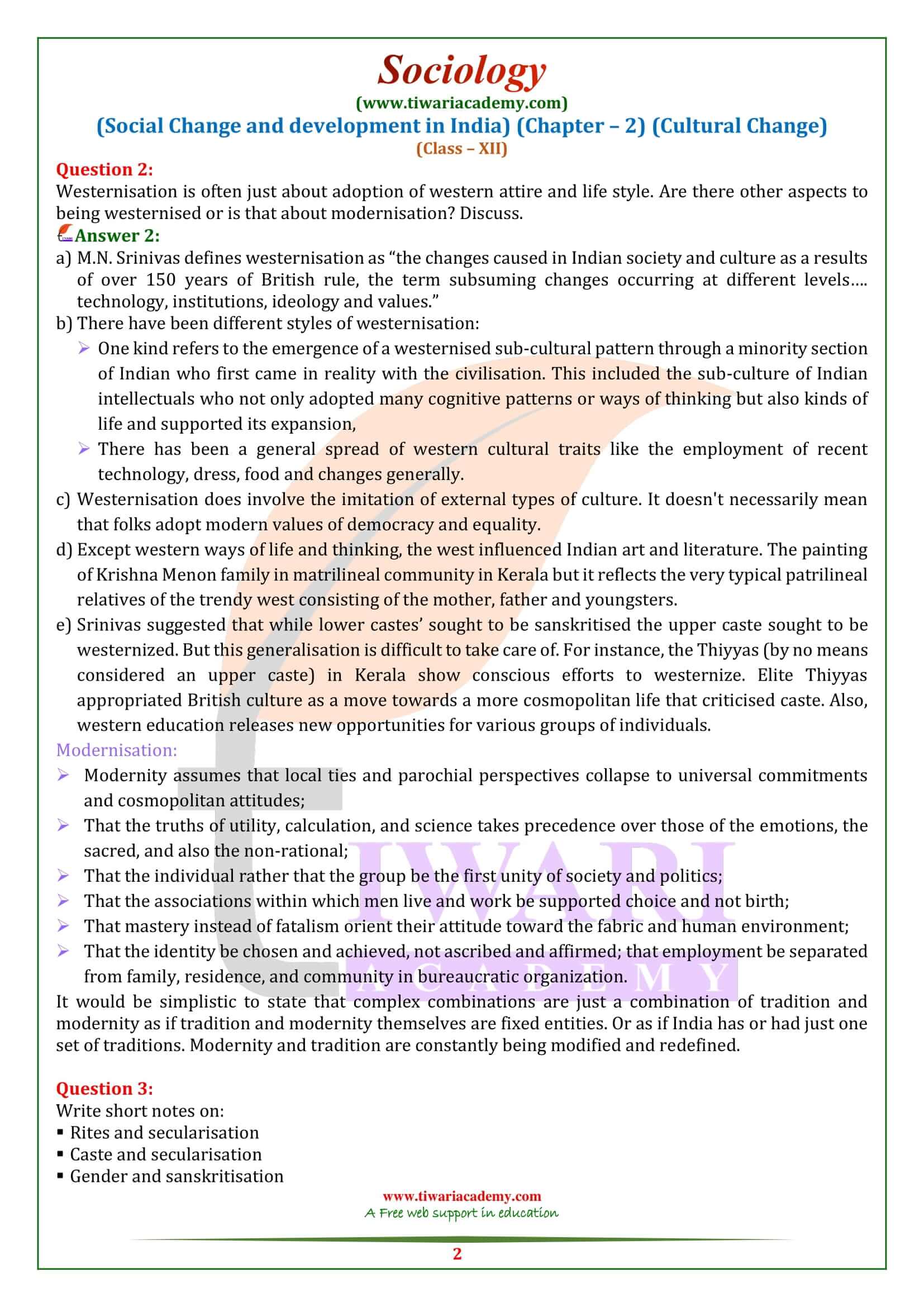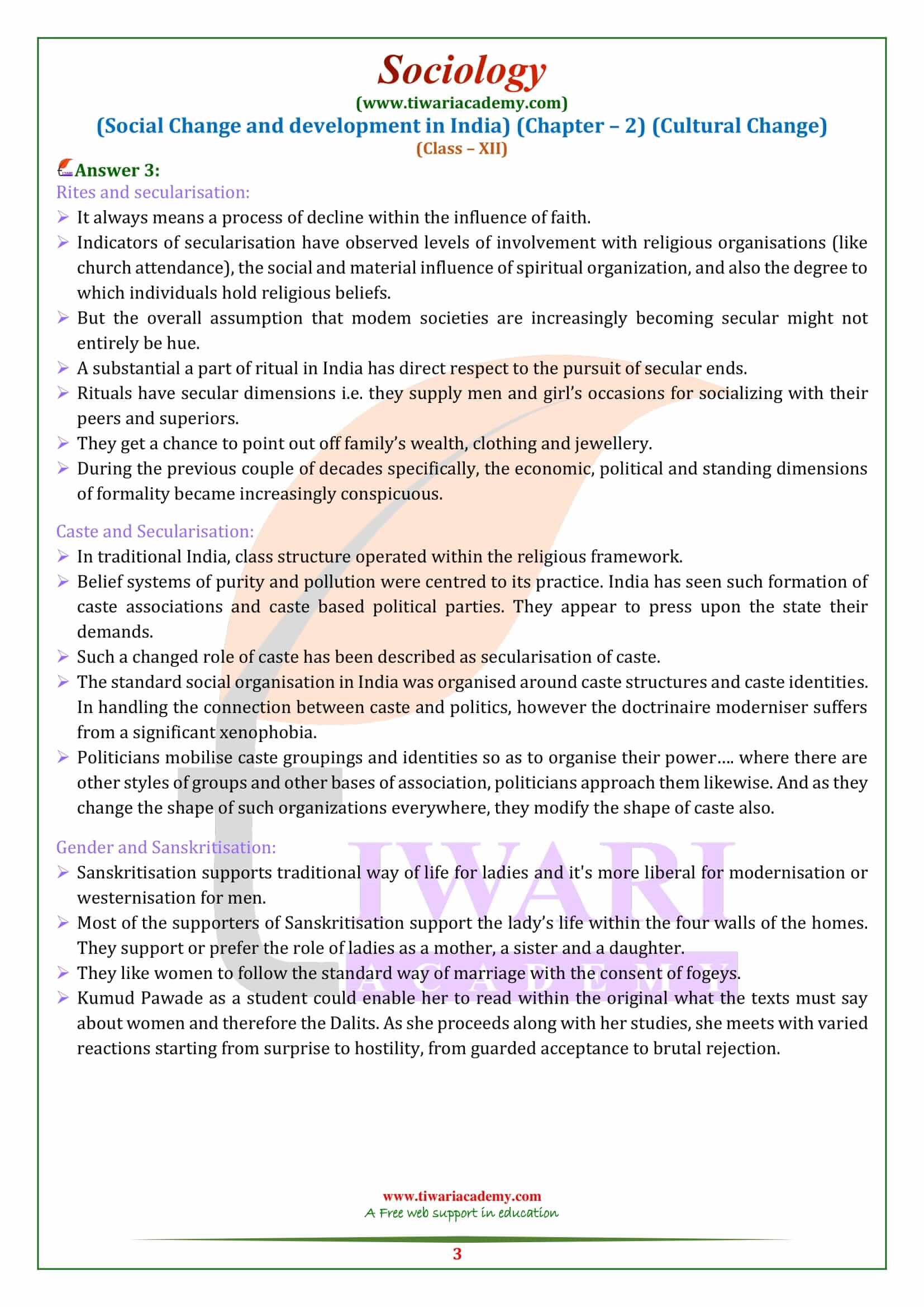NCERT Solutions for Class 12 Sociology Chapter 2 Cultural Change Exercises questions answers in English Medium for new academic session 2025-26. The MCQ and Extra questions of Class 12 Sociology Part 2 Social Change and Development in India chapter 2 are also given here with explanation.
Class 12 Sociology Chapter 2 Cultural Change Question Answers
Write a critical essay on Sanskritisation.
The term sanskritisation was coined by M.N. Srinivas. It should be defined because the process by which a caste or tribe or other group takes over the customs, ritual, beliefs, ideology and elegance of lifetime of a high and, specifically, a ‘twice-born (dwija) caste’.
Its influence is seen in language, literature, ideology, music, dance, drama, type of life and ritual.
It’s primarily a process that takes place within the Hindu space though Srinavas argued that it absolutely was visible even in sects and spiritual groups outside Hinduism.
It operated differently in several regions. In those areas where a highly sanskritised caste was dominant, the complete region underwent a specific amount of Sanskritisation. In those areas, where non-sanskritic castes were dominant, it absolutely was their influence that was stronger, this may be termed because the process of ‘de- sanskritisation’.
Srinivas argued that, the sanskritisation of a gaggle has usually the effect of improving its position within the local caste hierarchy. It normally presupposes either an improvement within the economic or political position of the group concerned or a better group self-consciousness resulting from its contact with a source of the ‘Great Tradition’ of Hinduism like a pilgrim centre or a monastery or a proselytising sect.
But in India, there are many obstacles to any easy taking up of the customs of the upper caste by the lower. Traditionally, the dominant castes punished those low castes, which was audacious enough to aim it.
Sanskritisation refers to a process whereby people want to enhance their status through adoption of names and customs of culturally high-placed groups. The “reference model’ is sometimes financially more contented. In both, the aspiration to be just like the higher placed group occurs only people become wealthier.
Criticisms of Sanskritisation:
It’s been criticized for exaggerating social mobility or the scope of lower castes to maneuver up the social ladder. For it ends up in no structural change but only positional change of some individuals. Inequality continues to persist though some individuals is also ready to improve their position within the unequal structure.
The ideology of sanskritisation accepts the ways of the upper caste as superior which of the lower caste as inferior. Thus, the will to imitate the upper caste is seen as natural and desirable.
Sanskritisation seems to justify a model that rests on inequality and exclusion. It appears to suggest that to believe pollution and purity of groups of individuals is justifiable or alright. Therefore, to be ready to look down on some groups of individuals even as the upper caste looked down on the lower castes, could be a mark of privilege. It shows how such discriminatory ideas become some way of life. Rather than aspiring for an equal society, the exclusion and discrimination seek to offer their own intending to their excluded status. This provides rise to an undemocratic society.
Since sanskritisation leads to the adoption of upper caste rites and rituals it results in practices of secluding girls and ladies, adopting dowry practices rather than bride-price and practising caste-discrimination against other groups.
The effect of such a culture is that it erodes characteristics of Dalit culture and society. As an example, the very worth of labour which lower castes degraded and rendered shameful. Identities supported the premise of labour, crafts, artisanal ability are regarded useless.
Write short notes on Rites and secularisation.
Rites and secularisation:
- It always means a process of decline within the influence of faith.
- Indicators of secularisation have observed levels of involvement with religious organisations (like church attendance), the social and material influence of spiritual organization, and also the degree to which individuals hold religious beliefs.
- But the overall assumption that modem societies are increasingly becoming secular might not entirely be hue.
- A substantial a part of ritual in India has direct respect to the pursuit of secular ends.
- Rituals have secular dimensions i.e. they supply men and girl’s occasions for socializing with their peers and superiors.
- They get a chance to point out off family’s wealth, clothing and jewellery.
- During the previous couple of decades specifically, the economic, political and standing dimensions of formality became increasingly conspicuous.
What do you understand by Caste and secularisation?
Caste and Secularisation:
In traditional India, class structure operated within the religious framework.
Belief systems of purity and pollution were centred to its practice. India has seen such formation of caste associations and caste based political parties. They appear to press upon the state their demands.
Such a changed role of caste has been described as secularisation of caste.
The standard social organisation in India was organised around caste structures and caste identities. In handling the connection between caste and politics, however the doctrinaire moderniser suffers from a significant xenophobia.
Politicians mobilise caste groupings and identities so as to organise their power…. where there are other styles of groups and other bases of association, politicians approach them likewise. And as they change the shape of such organizations everywhere, they modify the shape of caste also.
Explain the terms Gender and sanskritisation.
Gender and Sanskritisation:
Sanskritisation supports traditional way of life for ladies and it’s more liberal for modernisation or westernisation for men.
Most of the supporters of Sanskritisation support the lady’s life within the four walls of the homes. They support or prefer the role of ladies as a mother, a sister and a daughter.
They like women to follow the standard way of marriage with the consent of fogeys.
Kumud Pawade as a student could enable her to read within the original what the texts must say about women and therefore the Dalits. As she proceeds along with her studies, she meets with varied reactions starting from surprise to hostility, from guarded acceptance to brutal rejection.




